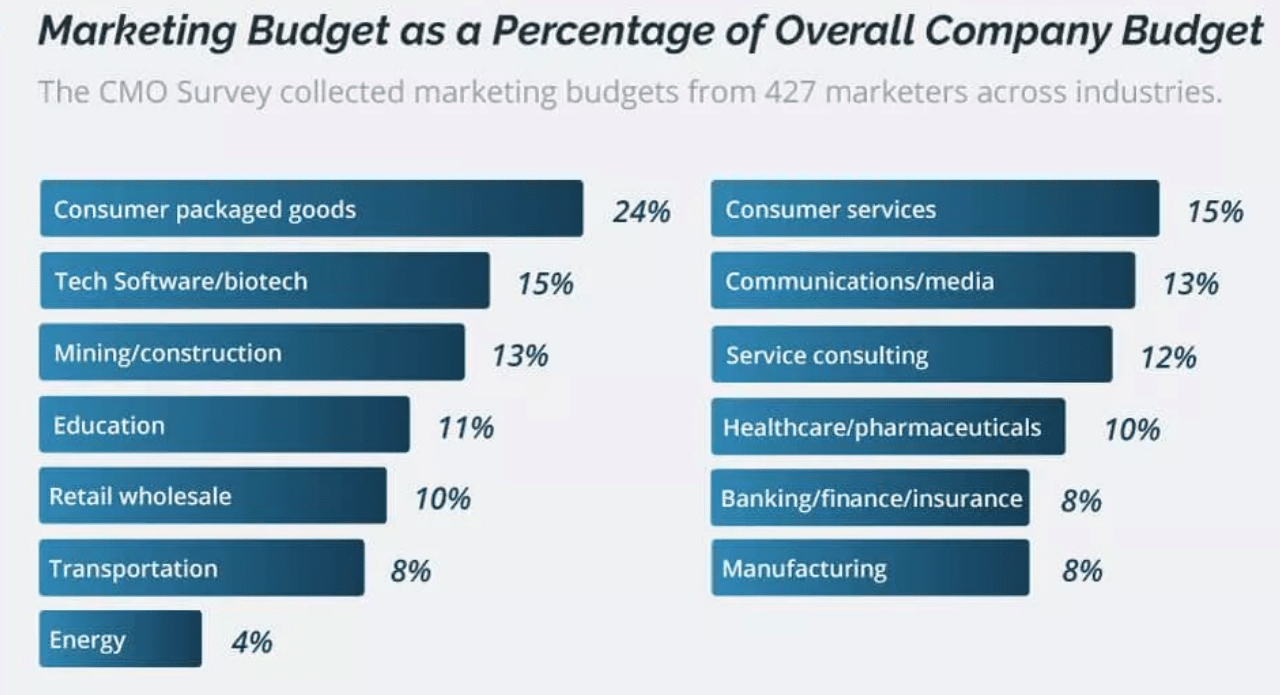For too many companies this is a painful and confusing equation as they try to balance revenue, returns, and sales forecasts. But the equation is easier than you think and it starts with knowing what industry standards for marketing budgets look like.

Hey CMO’s! Ready for 2024? Read our Calculating a Marketing Budget: A Guide for CMOs
Marketing Budgets | Who’s Spending What?
Likely, you’re no Google or Microsoft, so it pays to scale to the industry level that most closely mirrors your business. Consider this helpful tool which shows the industry marketing budget as a percentage of top-line revenue.
A 2019 Gartner/CMO Magazine report showed major public companies spend more than 10 percent of their top-line revenue on marketing. These budgets are comprised of marketing employees, consultants, and vendors along with actual spend on digital, social, public relations, print, video, and software related to marketing. (Discover more about companies investing the most in marketing.)

In a study by SharpSpring and Footwasher Media, the report showed that companies that fall below 5 percent in their total marketing budget as a percentage of revenue (a modest investment), experience slow growth or no growth at all. Their study suggests that there is a direct correlation between company success/growth and marketing investment.
Where is AI in Marketing Budgets?
According to 2023 data from Influencer Marketing Hub the use of AI is only ramping up in use among marketers and in the percentage of their marketing budget on AI-driven campaigns.
- 61.4% of marketers have used AI in their marketing activities.
- 44.4% have used AI for content production.
- 19.2% of marketers spent more than 40% of their marketing budget on AI-driven campaigns
Calculating Your Marketing Budgets
It can take a little homework to get these numbers and make your calculation, but the inclusions are relatively simple to sort.

If you’re a CMO dig deeper into our Guide to Calculating Marketing Budgets for CMOs.
+ Your Team (Internal Expenses). Consider the teams, departments, and contractors – whether full-time or part-time – you employ to directly assist with marketing. Calculate the hours invested and the cost per hour. (Note: This is marketing, not sales! While these two areas are often confused and lines blurred, there is a significant distinction. Sales departments and teams will directly affect purchases and sales. Marketing is the efforts and investments made to support your Sales teams. Still confused? SharpSpring says it best,
“Sales is not marketing. If your marketing budget includes sales, and it stands at 10%, your actual marketing budget is more likely around 3%. This creates a classic conflict between sales and marketing staffs. Marketing blames Sales for being incompetent, and Sales blames Marketing for being clueless. In the end, the real blame lies in the C-suite for not properly allocating resources.”
+ Your Outside Investments (External Expenses). These investments include tradeshows, events, and training related to marketing your business. They also include outside agencies, consultants, and software you might lean on to market your company. Add these up over a 12-month period to calculate your investment.
Time for more math. [(Internal + External) / Total Revenue]
/ Divide By Revenue. Now divide your total marketing investment (Internal + External) by your top-line revenue by your total marketing investment. This will give you the percentage of top-line revenue your company invests in marketing.

Where Did Your Marketing Budget Land?
You don’t have to spend ridiculous amounts of money to see results, but properly calculated investments will yield results. If you fall under 10% compare your industry to like industries to see how much others invest. Then ask your executive teams if your marketing budget has been enough to achieve your marketing objectives. If not, it’s time to reallocate resources and adjust your budgets to achieve the desired results. (Discover more about who is spending what on their marketing budgets)
Let Fajen Consulting help you better understand how to achieve your marketing goals.
